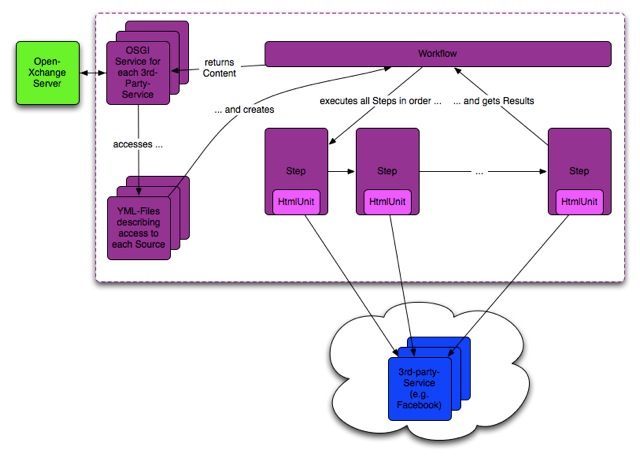CrawlerArchitecture: Difference between revisions
(US 97798972, remove everything related to facebook) |
|||
| (3 intermediate revisions by 2 users not shown) | |||
| Line 1: | Line 1: | ||
= Architecture of the crawler bundle = | = Architecture of the Social OX PlugIn (crawler) bundle = | ||
Each 3rd-Party-Service | Each 3rd-Party-Service is represented by a separate | ||
OSGI-Service-instance (type | OSGI-Service-instance (type "GenericSubscribeService"). These services | ||
each contain a description (type | each contain a description (type "CrawlerDescription") of how to access | ||
"their" 3rd-Party-Service. Every time the OSGI-Bundle | |||
"com.openexchange.subscribe.crawler" is started these descriptions get updated via | |||
reading YML-files (one for each 3rd-Party-Service). So to update a | reading YML-files (one for each 3rd-Party-Service). So to update a | ||
"Crawler" a new YML-file has to be placed in the appropriate directory | |||
and the OSGI-Bundle has to be restarted. | and the OSGI-Bundle has to be restarted. | ||
When a user hits the refresh-button of a subscription the respective | When a user hits the refresh-button of a subscription the respective | ||
OSGI-Service creates a new workflow-instance (type | OSGI-Service creates a new workflow-instance (type "Workflow") from its | ||
description, inserts the user´s credentials (decrypted using his login | description, inserts the user´s credentials (decrypted using his login | ||
password) and executes the workflow. The workflow then executes each each | password) and executes the workflow. The workflow then executes each each | ||
Step (type | Step (type "Step") in order. The output of each step is given to its | ||
successor as input. The output of a | successor as input. The output of a workflow's final step is the wanted | ||
content (e.g. a list of Contacts) and is returned, via the OSGI-Service, to | content (e.g. a list of Contacts) and is returned, via the OSGI-Service, to | ||
the OX-Server. | the OX-Server. | ||
Latest revision as of 12:50, 7 July 2015
Architecture of the Social OX PlugIn (crawler) bundle
Each 3rd-Party-Service is represented by a separate OSGI-Service-instance (type "GenericSubscribeService"). These services each contain a description (type "CrawlerDescription") of how to access "their" 3rd-Party-Service. Every time the OSGI-Bundle "com.openexchange.subscribe.crawler" is started these descriptions get updated via reading YML-files (one for each 3rd-Party-Service). So to update a "Crawler" a new YML-file has to be placed in the appropriate directory and the OSGI-Bundle has to be restarted.
When a user hits the refresh-button of a subscription the respective OSGI-Service creates a new workflow-instance (type "Workflow") from its description, inserts the user´s credentials (decrypted using his login password) and executes the workflow. The workflow then executes each each Step (type "Step") in order. The output of each step is given to its successor as input. The output of a workflow's final step is the wanted content (e.g. a list of Contacts) and is returned, via the OSGI-Service, to the OX-Server.
